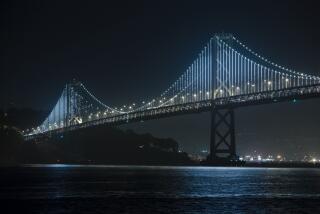Hard to Destroy, Hard to Fix and Easy to Love
- Share via
CRESCENT CITY, Calif. — Guy Towers shifted uneasily from foot to foot, straining to hear the thwack-thwack of helicopter blades through the fog. The chopper and its first load of passengers had disappeared into the mist nearly an hour earlier on a trip over the frigid sea that was supposed to take only a few minutes.
Wispy tendrils of fog were now wrapping around the town’s airport, threatening to shut it down. The pressure mounted as more people arrived on the tarmac, ready for a helicopter ride to see Towers’ magnificent obsession: the St. George Reef Lighthouse.
Towers describes the 111-year-old structure as the only offshore lighthouse in the United States with public access. Public access, that is, when the weather is cooperating -- which in this northwest corner of California, known for its fog, gale-force winds and 75-plus inches of rain a year, isn’t all that often.
“Are they lost?” asked Marilyn McLaughlin, putting a voice to the collective angst of the St. George Reef Lighthouse Preservation Society. “Does he know how to get back?”
Towers got on the two-way radio and chatted with a flustered pilot searching fruitlessly for the lighthouse, which is a mere six miles offshore.
“I cannot find it,” the pilot said. “It’s buried in the fog.”
Towers mustered a weary smile. He’s been in this situation before. “It is,” he said, “the old fog, touch and go.”
To tackle the restoration of an offshore lighthouse is to take on the elements themselves. Getting there is dicey. Getting back is never a sure thing, either. And it is during those precious few hours spent at the lighthouse that the real battle unfolds.
On a recent Sunday. Towers pulled off a chunk of peeling paint, explaining how in the 28 years since the Coast Guard abandoned the lighthouse and replaced it with a navigational buoy, the sun, the wind and the salt spray have taken their toll.
The ornate wrought-iron handrails long ago rusted and toppled into the sea. Peeling plaster and paint hang from vaulted ceilings. Rotten wood floor joists poke through crumbling cement. Heavy iron doors hang ajar, so badly weathered and corroded that the Coast Guard seal is barely visible under a rusty red patina.
“Rust and corrosion from the elements,” Towers said. “That’s our enemy.”
Yet the core structure remains solid, he pointed out.
It should. The St. George Reef Lighthouse was constructed out of enormous blocks of granite by European stonemasons from 1882 to 1892 for $704,633 -- making it the most expensive ever built in the United States. It was fortified like a castle to withstand 100-mph winds and wintry dousings of 50-foot waves. (A Coast Guard helicopter crew once reported seeing seaweed draped over the top of the lantern room, 144 feet above the pitching seas.)
“It’s a monstrous structure, as solid as the day it was built,” Towers said.
Carrying the name of St. George, the dragon slayer, the lighthouse was built on one of the ship-eating “Dragon Rocks” off this coastline that sank the steamer Brother Jonathan in 1865, claiming more than 150 lives.
During its years of operation, the lighthouse proved fatal to five of its keepers. Three Coast Guardsmen and two from the now-defunct U.S. Lighthouse Service lost their lives either trying to reach the lighthouse by boat or on the wave-washed rock upon which the lighthouse perches.
Boat landings are nearly impossible on the rock, so keepers had to be hoisted by a swinging boom from the roiling deck of a boat onto the rock.
Lighthouse keepers would spend weeks at a time there. Scheduled rotations were routinely interrupted by the weather, so the place was designed for long stays.
A rainfall catchment system funneled fresh water into 60,000-gallon cisterns. A coal house and engine room kept the foghorn booming and the Fresnel lens casting a red-and-white beam 20 miles out to sea.
The three resident lighthouse keepers lived in separate rooms, stacked one upon the other, in the six-story tower. Initially, each of the quarters had redwood wainscoting, tongue-and-grove flooring, built-in bunk beds and shiny brass fixtures.
Much of the initial detail is gone, lost to the elements, to remodeling by the Coast Guard or subsequent plundering by scavengers during the years the lighthouse was abandoned.
The St. George Lighthouse Preservation Society, with a lease from the National Park Service and Del Norte County, plans to restore it all. Although work is hampered by logistics and funding, its small band of volunteers is making headway.
In October, the society replaced the lantern room and installed a light powered by solar and wind energy, so the lighthouse once again winks at passing ships.
All this is being financed by lighthouse lovers like Elizabeth Ratkovich, one of 45 people who toured the structure on this Sunday after the veil of fog finally lifted, allowing the helicopter to find the lighthouse and begin shuttling people back and forth from the Crescent City airport.
“It was fabulous,” said Ratkovich, a schoolteacher from Sacramento. Like others on the tour, Ratkovich acknowledged that she is “nuts about lighthouses.”
“Lighthouses are our castles in this country,” she said. “This was the best I have ever seen.”
The St. George Lighthouse Preservation Society -- www.stgeorgereeflighthouse.us -- arranges periodic tours, particularly in the spring and late fall.
More to Read
Sign up for The Wild
We’ll help you find the best places to hike, bike and run, as well as the perfect silent spots for meditation and yoga.
You may occasionally receive promotional content from the Los Angeles Times.






